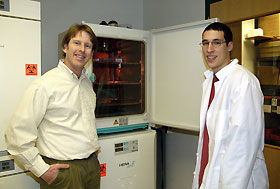Professors Urge State To Fund Stem Cell Research
 |
| Theodore Rasmussen, left, assistant professor of animal science, and graduate student Dominic Ambrosi stand in front of a stem cell incubator in the Advanced Technologies Laboratory on the Storrs campus. |
|
Photo by Dollie Harvey |
Citing one example after another regarding promising research at UConn involving embryonic and adult stem cells, three UConn professors last week urged members of the legislature’s Public Health Committee to follow the lead of Gov. M. Jodi Rell and a number of key legislators and support a bill funding further research in the field.
Dr. Marc Lalande, professor and chair of the Department of Genetics and Developmental Biology at the Health Center; Xiangzhong “Jerry” Yang, director of the Center for Regenerative Biology in Storrs; and Theodore Rasmussen, an assistant professor of animal science, hailed the proposal to provide as much as $20 million over two years to augment stem cell research in Connecticut. It is expected that most of the funding would go to UConn and Yale University, each of which has a number of ongoing research programs using stem cells, primarily mouse stem cells.
Embryonic stem cells, which form early in an embryo’s development, can become any cell in the body.
Proponents of stem cell research say the cells hold the promise of leading to cures for some of the most intractable diseases known to man, including Parkinson’s disease, diabetes, Alzheimer’s disease, and others.
Several faculty attended the hearing.
“The governor’s and legislature’s expression of support for funding is prudent because of the potentially immeasurable benefits to society if the envisioned promise of this research is ultimately received,” said Lalande. “In addition to the potential scientific advancements, there is another significant benefit to the state of Connecticut derived from funding this research – its economic impact. In order for Connecticut to maintain its competitive edge in the pharmaceutical and biotechnology industries, our University must educate and train scientists to become highly skilled in stem cell techniques.”
Legislatures in California, Wisconsin, and New Jersey have already stepped forward with millions of dollars for stem cell research. Yang told legislators that it is vital for Connecticut also to step up its funding, or risk losing scientists and students to other states and countries where the use of stem cells in research is encouraged, and funded.
Lalande also urged the legislators to rewrite portions of the bill so it more clearly includes the use of mouse and other animal embryos, with which most of the UConn researchers are working. Advances in mouse stem cell research are transferable to humans. Additionally, federal law currently restricts the use of human embryos for research, so state-sponsored research using human embryos would likely require UConn to build new laboratories, segregated from any projects supported by federal dollars.
UConn researchers using stem cells from mice and other animals are investigating how cells can be used for bone repair; how to generate the neurons lost in Parkinson’s disease; how to engraft neuronal and dental pulp stem cells into mice; and dozens of other uses. Overall, Lalande says, there are more than a dozen teams of researchers at the Health Center and Storrs campus involved in research using stem cells.
One of the larger teams is at the Center for Regenerative Biology, which has hired six faculty members from around the nation with expertise in embryonic and adult stem cells, therapeutic cloning, cell culture, and tissue engineering.
“Recognizing that the goal is to ultimately move the science from the laboratory bench to therapies that will benefit patients, it is important to state clearly that any therapeutic applications are years from realization,” Lalande told legislators. “Before stem cell therapies for neurological diseases, spinal cord injuries, heart disease, diabetes, Parkinson’s disease, osteoporosis, cancer, and Alzheimer’s disease can be developed, research funds are urgently needed so that scientists can answer several critical questions about how stem cells grow and how they acquire their specialized functions.”
Added Lalande, “The University fully supports your efforts in this regard.”

